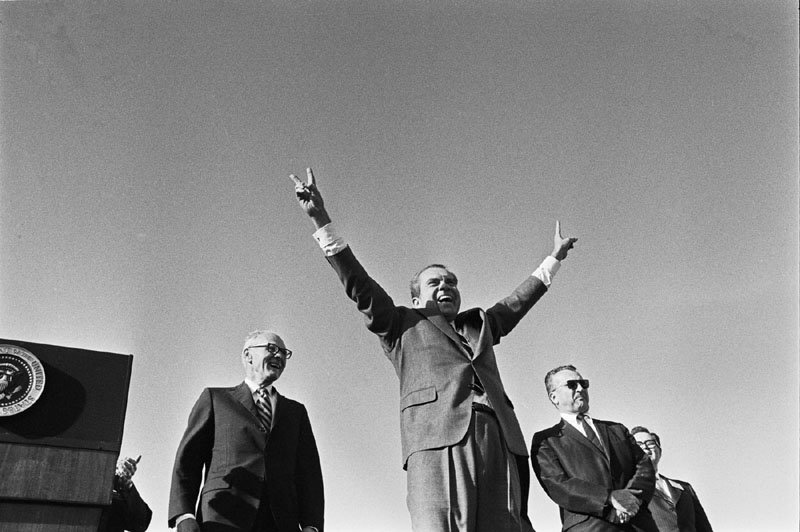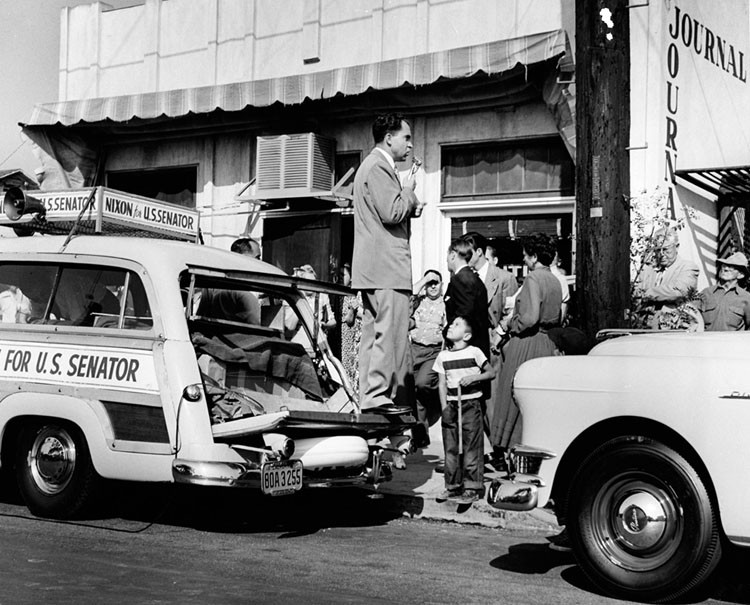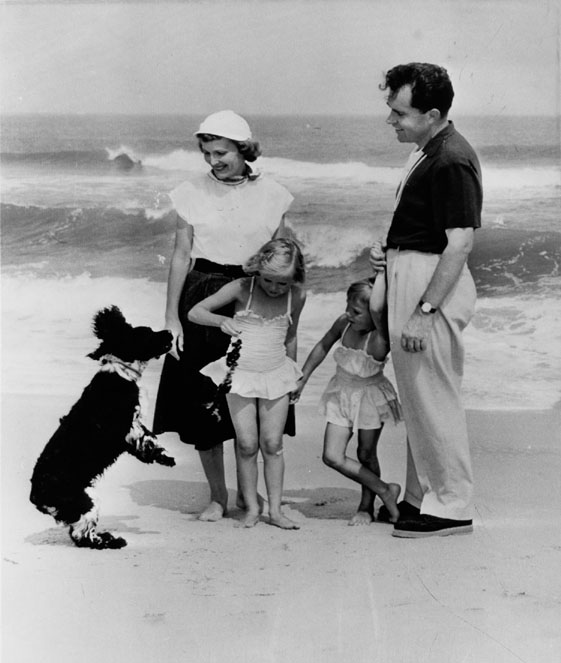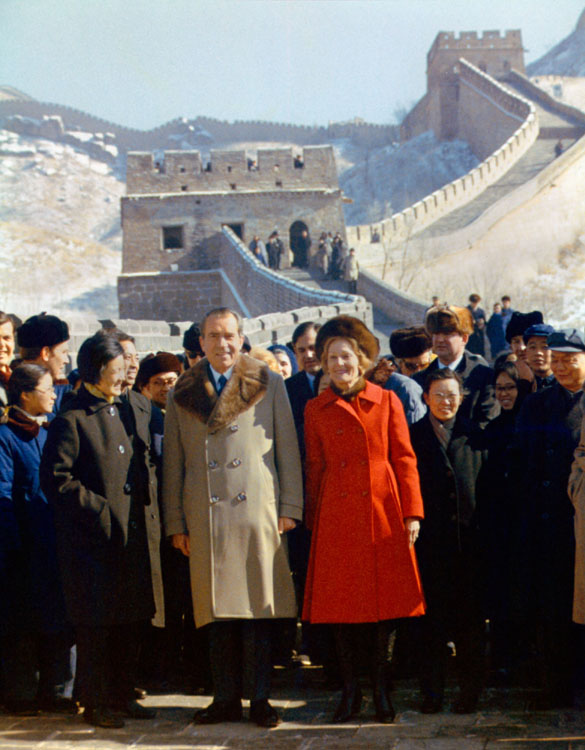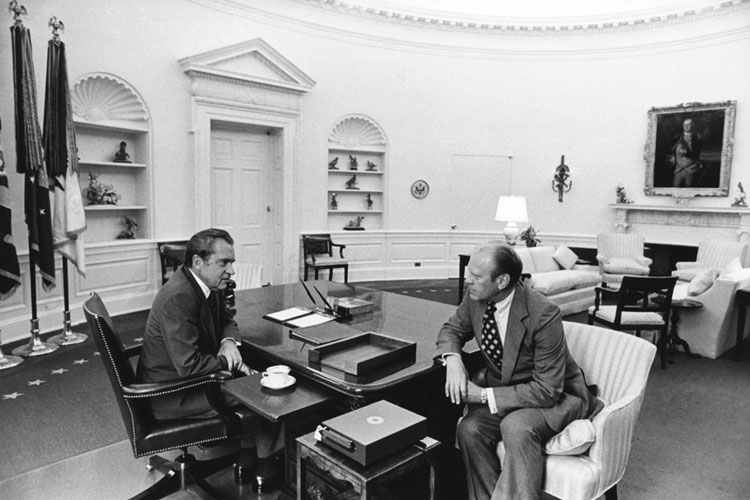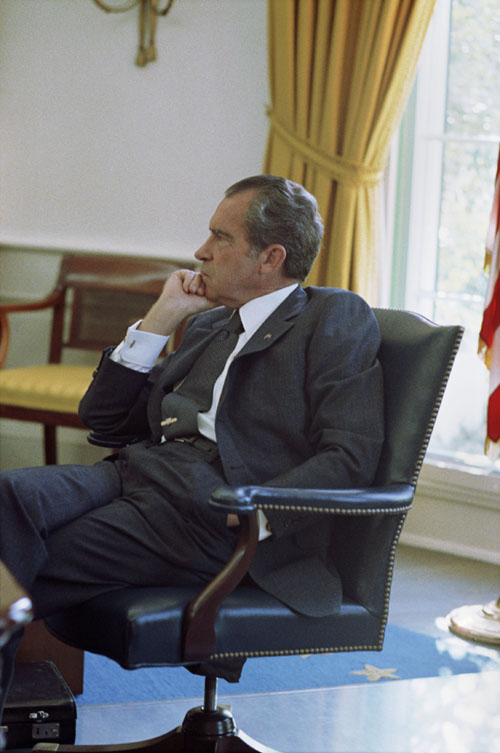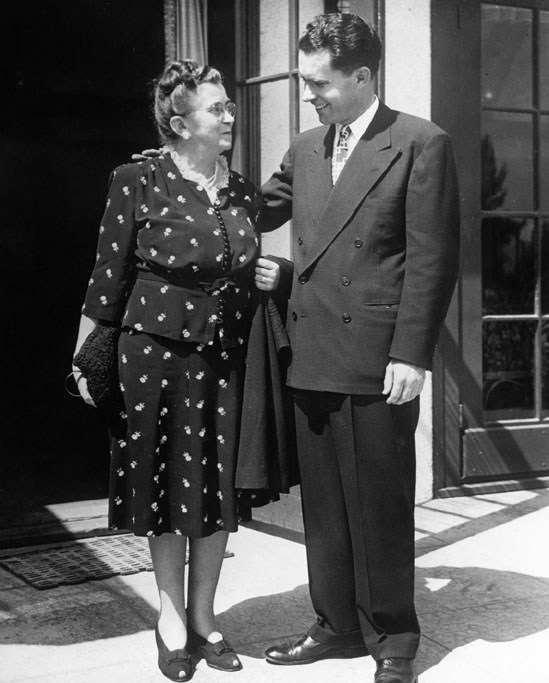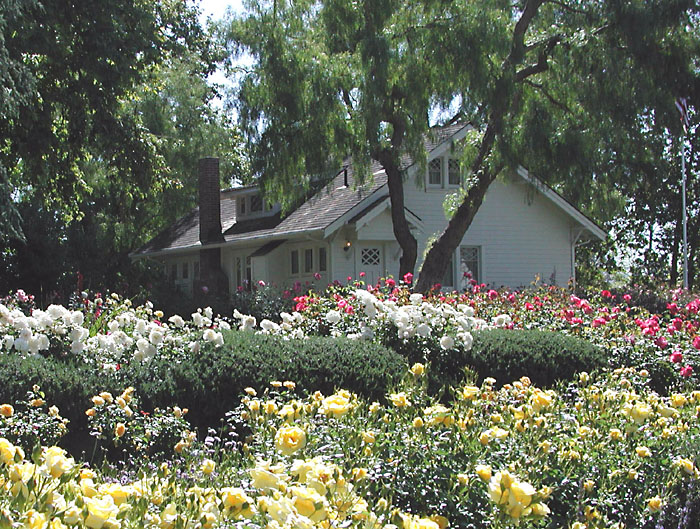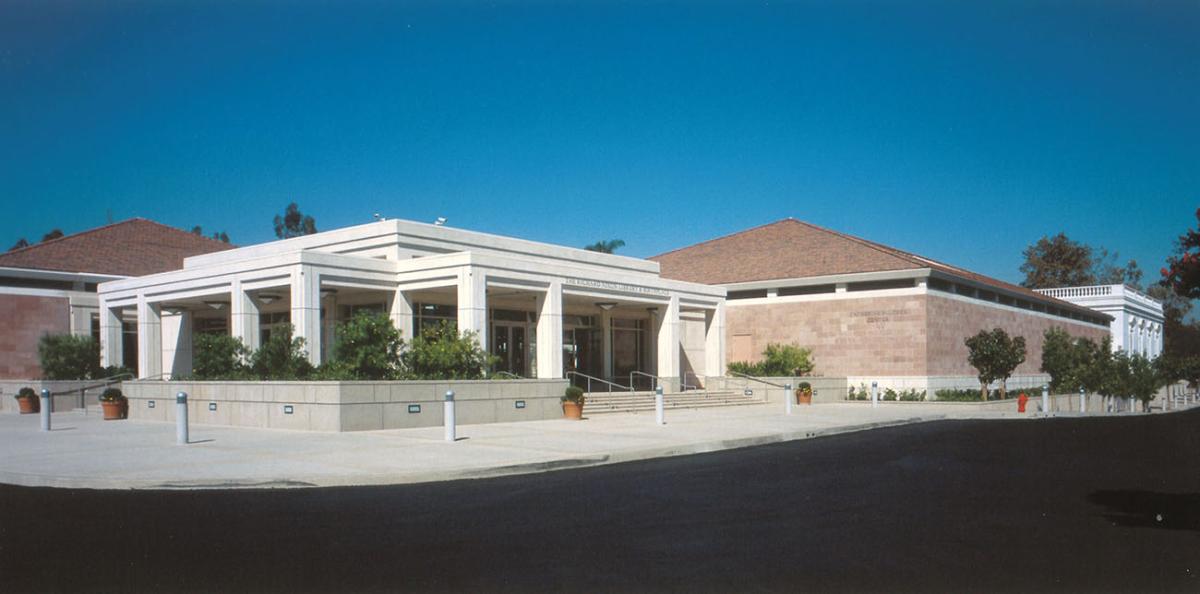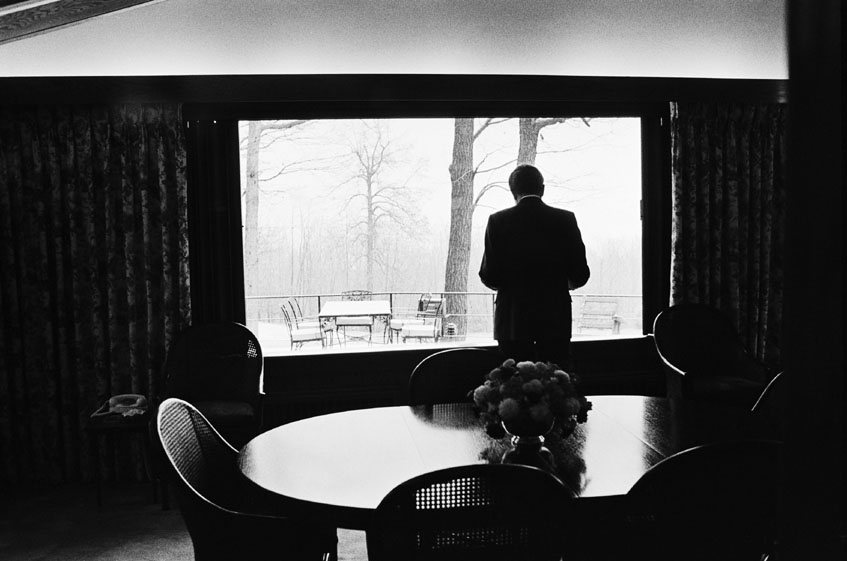
Nixon’s Library Now a Part of NARA
California Facility Will Hold All Documents and Tapes From a Half-Century Career in Politics
Fall 2007, Vol. 39, No. 3
By James Worsham

For nearly a half-century, Richard Milhous Nixon was, as he was fond of saying in Theodore Roosevelt's words, "in the arena." Indeed, Richard Nixon has never been out of the arena—or out of our political consciousness.
Post–World War II generations of Americans grew up watching his political career unfold. From a young congressional candidate just out of uniform in 1946, he rose through Congress, the vice presidency, and the presidency. After resigning under threat of impeachment in 1974, he embarked on an active period as a senior statesman.
Even since his death in 1994, Nixon has remained a prominent yet polarizing figure. Continuing interest in his career—successes and setbacks, and the Watergate affair, including his resignation and pardon—has produced television documentaries, movies, best-selling books, and even a new Broadway play.
Nevertheless, Richard Nixon lacked a credential common to all other modern Presidents: membership in the federal government's presidential library system, which every other President since Herbert Hoover has enjoyed. Now, that has changed.
On July 11, 2007, the National Archives—with the approval of Congress—established the Richard Nixon Presidential Library and Museum in the private facility built in his honor in Yorba Linda, California, by the Richard Nixon Library and Birthplace Foundation. The new Nixon Library is staffed and operated by federal employees working under a director appointed by the Archivist of the United States.
The establishment of a presidential library means that eventually all of the records, artifacts, and other materials—including taped White House conversations—that document Richard Nixon's long public career will be archived and preserved in one place, creating a major research center in southern California for the study of the 37th President and the dramatic era in which he lived.
From the private library in Yorba Linda come 6.2 million pages of records, 19,000 still photographs, 150 reels of film, 900 audio recordings of Nixon speeches, 3,000 books, and assorted collections of original political cartoons, campaign posters, and political memorabilia.
These pre-presidential and post-presidential materials will join the extensive Nixon presidential collection already under the care of the National Archives: 42 million pages of records, 300,000 still photographs, more than 30,000 gifts Nixon received as President, 700 hours of film, 4,000-plus hours of "off-air" video recordings, 4,469 audio recordings, and nearly 3,800 hours of White House taped conversations, of which approximately 2,000 hours are already available for research. Copies of the taped White House conversations will continue to be available at the National Archives in College Park, Maryland, as will any other conversation tapes opened in the future.Over the next several years, pending construction of a suitable addition to the existing library, all these records will be brought together on the nine-acre site in Yorba Linda, about 40 miles southeast of Los Angeles. There, the NARA facility will operate alongside Nixon's birthplace and the grave sites of the President and Mrs. Nixon.
Archivist of the United States Allen Weinstein made the goal of bringing the private Nixon Library into the federal system one of his top priorities upon taking office in early 2005, saying that it was long overdue.
"This is a historic day for the National Archives as we welcome this institution into the federal system of presidential libraries," Weinstein said at the July 11 ceremony in Yorba Linda marking the transfer. "But today is also a historic day for the cause of history itself. We prepare to bring together, under one entity, all the records and artifacts relating to one of the major figures in national and world politics for nearly a half-century, Richard Nixon."
"The result," he added, "will be a national resource—indeed, an international resource—for the study of the best-documented presidential administration in American history."
Timothy Naftali, director of the federally operated Nixon Library, sees the future of the library as an interactive multimedia facility that will provide "a full view, a 360-degree view" of Nixon's life and political career and of the developments in American history during the former President's nearly half-century in public life.
The private Nixon Foundation, which operated the Richard Nixon Library and Birthplace for 17 years, will be a major source of support for activities that cannot be funded with normal congressional appropriations. "We envision our role to be akin to that of foundations affiliated with the other libraries," said Rev. John Taylor, executive director of the Nixon Foundation.
The story of Richard Nixon, and the library that chronicles that story, begins where it ends: in Yorba Linda, California, where he was born in 1913.
A Historic Half-Century:
One Man's Role
The records of the Nixon presidency and Nixon's long public career, before and after his White House years, represent a wealth of resources for historians of the era. Not only do they document the actions and words of Richard M. Nixon throughout his public life, but they also shed a great deal of light on nearly 50 years of dramatic change at home and abroad—from World War II to the dawn of the 21st century—during which Nixon was often a major player on the world political stage.
Personal documents and photographs record Nixon's childhood in southern California and his years at Whittier College and Duke University Law School, then his service in the U.S. Navy during World War II.
Official and personal records also chronicle the early years of his political career which began when the nation was starting to adjust to the massive economic and social changes that 15 years of recovery from the Depression and winning a global war had brought to America.
Documents also add understanding to Nixon's ascent in Congress, which began with the onset of the Cold War and continued through the Alger Hiss case and the McCarthy "Red Scare" era at home. It was during this time that he gained national attention for his dogged pursuit of communist sympathizers and spies in government.
In 1952, Nixon, by then a national figure, was chosen to be the Republican running mate for World War II hero Dwight D. Eisenhower. His vice-presidential papers reveal how Nixon's political star quietly rose in the relatively serene 1950s. Events such as the famous "kitchen debate" with Soviet Leader Nikita Khrushchev and Eisenhower's several serious heart attacks thrust him into the spotlight, while the nation adjusted to peace and prosperity and the forces gathered for changes that came in the 1960s.
Defeated in his first bid for President in 1960 by John F. Kennedy, Nixon ran for governor of California two years later, but lost again. Despite those losses, he never really left "the arena," campaigning for Republican candidates around the country during the following years, garnering support and IOUs for another campaign for the presidency. With the Democrats divided over the Vietnam War, victory finally was his in 1968, one of the most pivotal years in modern American history.
Records of the Nixon presidency document the major developments in both foreign and domestic policy that the nation experienced from 1969 to 1974. Nixon stunned the world by opening and normalizing relations with the People's Republic of China and visiting the Communist nation in 1972. He then was able to achieve détente with the Soviet Union, concluding the SALT I treaty and holding arms limitation talks. At home, opposition to the Vietnam War grew, as Nixon and Henry Kissinger, his top foreign policy adviser, sought a way out of Southeast Asia.
At the same time, a number of new progressive domestic programs, some of them now considered anathema to conservatives because of their broad reach, began under the centrist Republican Nixon administration and the heavily Democratic Congress. They include the establishment of the Environmental Protection Agency and the Occupational Health and Safety Administration. Affirmative action and antidiscrimination programs were broadened and strengthened, and school desegregation in both the north and south proceeded apace. Apollo 11 took Americans to the surface of the Moon in 1969, beginning a series of Moon missions.
As he did after his electoral defeats in 1960 and 1962, however, Nixon returned to "the arena." Following his resignation and the controversy surrounding his pardon by President Gerald R. Ford, Nixon wrote books, lectured, gave interviews, visited foreign leaders, and served as an informal adviser to his successors in an effort to restore his reputation. In 1981, the Nixons moved to New Jersey, closer to their daughters, Tricia and Julie, and their four grandchildren. Pat Nixon died in 1993, and the former President died in 1994; they are buried just a few feet from the house in which Nixon was born.
Ultimately, the burglary of the Democratic National Committee headquarters in June 1972, and the subsequent series of events in what is now known as the Watergate scandal, created strong congressional and public opposition to the Nixon Administration—especially with the publication of the transcripts of the White House tapes. It all forced Nixon, under threat of impeachment, to become the first U.S. President to resign from office.
After Congress declared in late 1974 that Nixon's presidential records were government property, Nixon was never able to regain ownership or control of his presidential papers. They were held at the National Archives for processing and preservation, a task that has kept NARA employees busy for many years.
The Presidential Materials:
A Special Place at NARA
Soon after he left office in 1974, Nixon signed an agreement with the administrator of the General Services Administration (of which NARA was then a part) giving the former President control over his presidential materials, including the tapes, as well as the right to destroy the tapes after five years.
However, Congress quickly stepped in and passed, and President Ford signed, the 1974 Presidential Recordings and Materials Preservation Act, which directed the government to take custody of Nixon's presidential materials and preserve them at the National Archives.
The 1974 law also required that these materials remain in the Washington, D.C. area, and the National Archives established the Nixon Presidential Materials Staff. This unit of the National Archives is located in College Park, Maryland, and preserves all the records of Nixon's term as President, from January 20, 1969, to August 9, 1974. These records are now part of the Nixon Library and will eventually be moved to Yorba Linda.
The 1974 act stipulated that the seized materials relevant to the "abuse of government power and Watergate" were to be processed and released to the public before the release of other materials. It also stated that the National Archives must segregate and return to Nixon or his heirs materials identified as purely "private-personal" or "private-political," neither of which had any bearing on his official, constitutional, and statutory duties as President.
NARA drew up the regulations on how it would process Nixon materials under the 1974 legislation, but successive versions of these regulations were challenged in court. In 1979, there was consensus on a sixth version, known as the "negotiated agreement," which offers the definition of "private-personal" and "private-political."
Meanwhile, President Nixon himself had sued, arguing that the 1974 PRMPA constituted an illegal search and seizure of his personal property. The Supreme Court upheld the government's authority to seize the materials but said that Nixon should be compensated. The suit was settled in 1998 with a $16 million payment to the Nixon estate.
In 1991, the watchdog group Public Citizen and historian Stanley Kutler sued NARA for not abiding by its own regulations for the processing and release of the Nixon tapes. The President himself joined in the lawsuit, seeking return of "personal" portions of the tapes before any more were released. It was settled in 1996, with the "tapes settlement agreement," which guides how processed tapes are now released.
"It was a contentious and stressful era," said Karl Weissenbach, director of the Nixon Presidential Materials Staff from 1993 to 2005. "You had different people with different agendas trying to tell you how to provide access to the tapes and papers, but we had to adhere to the law and the regulations."
Weissenbach, now deputy director of the Eisenhower Library in Abilene, Kansas, also said his staff was, to a great extent, a litigation staff. "Most of our work centered on responding to various legal challenges that focused primarily on access to Nixon's White House tapes and textual materials," he said. "We spent a lot of time responding to lawyers' requests for materials for the various lawsuits."
The first tapes released by the National Archives, about 12.5 hours made public in 1980, served as evidence in the Watergate trials. Close to 800 hours of tape are considered "private-personal" or "private-political" conversations. Eventually, the "private-political" conversations, which account for the bulk of these hours, will be processed and released under the agreement that brought the private library into the federal system.
Over the years, NARA has made major releases of Nixon tapes, drawing large numbers of media representatives to College Park and generating a considerable amount of press coverage of the revelations and conversations in the tapes. Taped telephone conversations between Nixon and Henry Kissinger, for example, have been quoted widely and were a major source for Robert Dallek's recent book, Nixon and Kissinger.
NARA already had in its holdings Nixon's vice-presidential papers, which were housed in its regional archives in Laguna Niguel, California. These papers have now been moved to the Nixon Library in Yorba Linda.
While the former President fought for his records and sought to rebuild his reputation, his friends moved to honor him.
A Gift from Friends:
A Private Library
In the early 1980s, while litigation over the presidential records continued, friends and supporters of the 37th President felt there was a need for a fitting tribute to him in his native state of California.
The Richard Nixon Library and Birthplace Foundation was created to honor Nixon in the same way all other modern Presidents since Herbert Hoover have been honored—with a presidential library. Between 1984 and 1990, the foundation raised $26 million in private funds to build that library and develop the site of Nixon's birth in Yorba Linda.
Originally, the group aimed for a site in San Clemente, California, which was the Western White House when Nixon was in office and his first post-presidency home, said John Taylor, executive director of the foundation.
"President Nixon always kept a candle lit for Yorba Linda, which for one reason or another didn't seem practical to foundation officials until a promising site in San Clemente became embroiled in the city's mid-1980s land-use debates," Taylor recalled.
The foundation then turned to the city of Yorba Linda, which welcomed it and provided $1.3 million in land, he said.
Important to the former President, Taylor added, was that he got his "wish that [the library's] visitors would have the opportunity to see the house his father built." And he insisted that the house not be turned 180 degrees to face the library, as some individuals involved in the library planning had proposed, said Taylor.
In July 1990, the foundation opened the Richard Nixon Library and Birthplace on nine acres that includes the house where Nixon was born in 1913, the First Lady's Rose Garden, and a large reflecting pool—but without the records of the Nixon presidency.
"What you will see here, among other things, is a personal life," Nixon said at the dedication ceremony July 19, 1990, "the influence of a strong family, of inspirational ministers, of great teachers. You will see a political life, running for Congress, running for the Senate, running for Governor, running for President three times. And you will see the life of a great nation, 77 years of it—a period in which we had unprecedented progress for the United States. And you will see great leaders, leaders who changed the world, who helped make the world what we have today."
Today, the foundation's board of directors includes Nixon's daughters, Tricia Nixon Cox and Julie Nixon Eisenhower, and the late President's youngest brother, Edward.
The records that have been held by the private library include Nixon's private pre-presidential papers, which contain campaign files, 1946–1968; House and Senate files, 1947–1952; foreign correspondence files, 1947–1968; special correspondence files with such figures as John F. Kennedy, Lyndon B. Johnson, Martin Luther King, Jr., and J. Edgar Hoover; correspondence, trip, and appearance files for 1963–1968; and research subject files from 1960 and 1968. Also in the formerly private archives are Richard Nixon's post-presidential papers dating from August 1974 to April 1994. To complement these collections, the private library acquired several personal paper collections from different periods of Richard Nixon's life.
But because the records of Nixon's presidency (January 1969 to August 1974) were in the Washington area, as Congress stipulated, researchers had to visit both Yorba Linda and College Park, an arrangement not seen on either coast as ideal.
Congress Allows a Historic Merger
The divided nature of Nixon records had over the years made the Nixon presidency stand out as an anomaly—a reminder of Watergate, giving it more emphasis at the expense of the study of other Nixon records concerning foreign affairs and domestic policy.
Bringing together all the Nixon records—pre-presidential, presidential, and post-presidency—had been discussed for years, at the National Archives, in Yorba Linda, and within the Nixon family. But doing so required an act of Congress. In 2004, Congress repealed the provision in the 1974 statute that required that the Nixon presidential materials remain in the Washington area and permitted NARA to accept, for a federally operated presidential library, the private Nixon facility once it met NARA health, safety, and environmental standards.
The way was then clear for bringing all the materials together in Yorba Linda.
A year later, Allen Weinstein, newly appointed ninth Archivist of the United States, announced he was making the inclusion of the Nixon Library in NARA's Presidential Library System a top priority. Within weeks, he was in touch with Taylor and met with him in Washington and Yorba Linda to agree on a rough timetable and other provisions.
Under the agreement, the Nixon Foundation deeded to the National Archives, concurrent with the transfer of the library to the government, the political portions of the White House tapes that had been excised and the political portions of Nixon's presidential papers returnable to President Nixon according to the 1974 legislation. The Nixon Foundation will sign a deposit agreement for the pre- and post-presidential materials and, in accordance with NARA's agreement, will work with NARA to execute deeds of gifts for these materials.
The foundation also agreed to assist the National Archives in revising and updating the museum, with the exhibit on Watergate the first to be changed. Over the years, visitors to the library had been able to see Nixon's life and career in 22 galleries depicting various chapters in his youth as well as in his long career in politics. Among the separate exhibits have been "Road to the Presidency" (the years in Congress); "Wilderness Years and the 1968 Campaign" (his life after the 1960 and 1962 electoral defeats); "Domestic Affairs Gallery" (his record in 10 domestic categories, such as health, the environment, and space); "Structure of Peace" (breakthroughs in foreign affairs, especially with the Soviets and the Chinese); and "Legacy" (his post-presidency accomplishments).
As the library's public programming become the responsibility of the National Archives, the foundation will retain responsibility for the gardens, the birthplace, and the Nixons' grave sites. In addition, the foundation will continue to operate the Nixon Center in Washington, D.C., which it describes as a bipartisan foreign policy institute for the study and analysis of policy changes in the United States.
In 2006, Weinstein designated Naftali, a scholar of international and presidential history, as the director of the federal Nixon Library. From October 16, 2006, through July 10, 2007, he served as director of the Nixon Presidential Materials Staff.
Naftali came to NARA from the Miller Center of Public Affairs at the University of Virginia, where he was associate professor and director of the presidential recordings program. He had also been a historical consultant to the Nazi War Crimes and Imperial Japanese Government Records Interagency Working Group, which, under NARA auspices, was responsible for declassifying millions of pages of material on the Nazi and Japanese war crimes and war criminals. He holds a doctorate in history from Harvard University.
Naftali promises a facility that tells the Nixon story in a nonpartisan, nonjudgmental, interactive way that leaves it up to visitors to draw their own conclusions. "This building will belong to everybody," he said, "and will be a national resource for scholars and a good neighbor for Californians, providing a setting for discussion, debate, and exploration of issues from the Nixon era as well as current issues."
Naftali also sees two special segments in the library's audiences. One audience is made up of children still in grade school and older students who now display little interest in history. "We have to try hard to ignite a passion for history in students, and that means looking for ways that not only educate, but also entertain and engage," he said. "Kids who grew up with the web have high expectations, and we need to be smart about using cutting-edge technology to get their attention."
He also said that another audience will be baby boomers, who want a nostalgic look at a turbulent era in which they lived. "Whether they loved or hated Richard Nixon," he said, "they share a keen interest in those years, and we have an obligation to provide programs and exhibits that are nonpartisan and objective."
Naftali and the NARA staff are currently working on the redesign of the Watergate gallery, scheduled to open in late 2007. The new gallery will provide a factual account of the events of Watergate that led to the President's resignation. Visitors will also have the opportunity to hear from many of those individuals involved in Watergate issues through new oral histories conducted by Naftali, NARA colleagues, and independent scholars.
On July 11, 2007, the new Nixon Library web site, www.nixonlibrary.gov, opened with the latest 11½-hour tape release and 50 documents selected from the simultaneous release of 78,000 pages of political materials that had been returned by NARA to President Nixon or the Nixon estate and were now deeded to the American people. The library will over time increase the availability of Nixon materials online, including new tape releases.
Richard M. Nixon:
Still "in the Arena"
Assembled in one place, under federal government auspices, all of the records of Richard M. Nixon's life create a rich, new landscape for historians and others for the study of one of the most well-known public figures of the second half of the 20th century.
The Nixon presidency is the most documented presidency in history, with textual records, artifacts, and tape recordings that include not only discussions about matters of war and peace, but also conversations that provide a rare look at the personality of a President.
And these records provide more than just documentation of Richard Nixon's words and deeds. They offer a unique vantage point from which to study the history of the nation during a half-century that saw enormous social, economic, and political changes at home and abroad.
Thirty-three years after his resignation and 13 years after his death, Richard Nixon remains a subject of widespread scholarly research, legal debates, and political critiques. Moreover, he remains very much "in the arena."
Note on Sources
Information and photographs for this article were provided by the Richard Nixon Presidential Library and Museum in Yorba Linda and College Park, the Richard Nixon Library and Birthplace Foundation, and NARA's Office of Presidential Libraries.
Also helpful was Stephen Ambrose's three-volume biography of Richard Nixon: Nixon: The Education of a Politician 1913–1962, Nixon: The Triumph of a Politician 1962–1972, and Nixon: Ruin and Recovery 1973–1990. Helpful too were Jonathan Aitken's biography, Nixon: A Life and David Greenberg's Nixon's Shadow: The History of the Image, as were the Public Papers of the President, 1974.
The phrase "in the arena" was used several times by Theodore Roosevelt, including a speech in Paris in 1910, arguing that those who count in life are not critics and observers, but "the doers of deeds . . . the man who is actually in the arena." Nixon subsequently used it as the title a 1990 book. And former Defense Secretary Caspar Weinberger also used it as the title of his memoirs.
